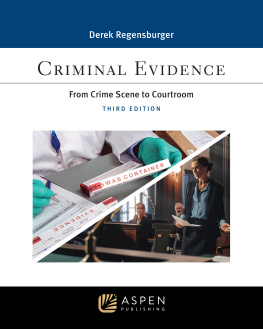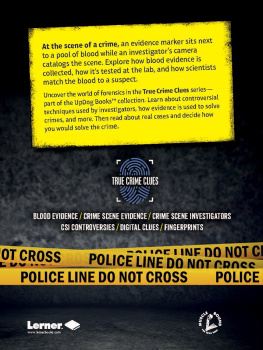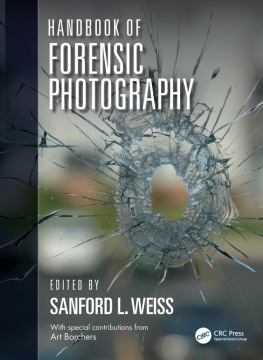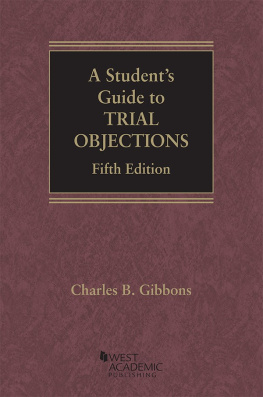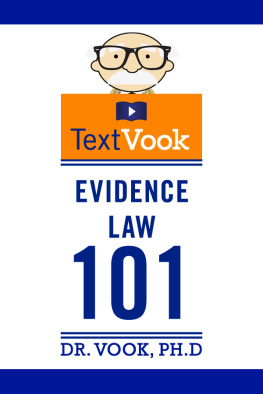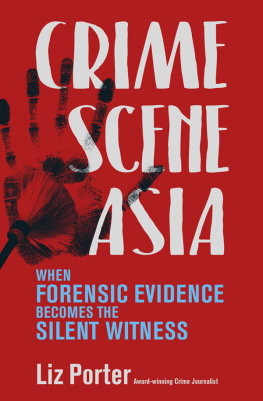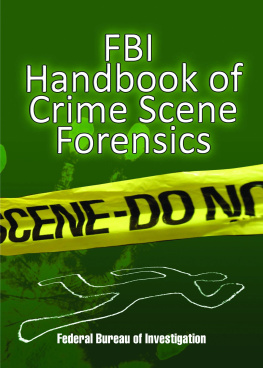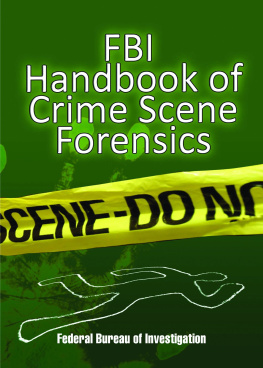Contents
Guide
Page List

i
Criminal Evidence
ii
Editorial Advisors
Alida V. Merlo
Indiana University of Pennsylvania
George E. Higgins
University of Louisville
G. Larry Mays
New Mexico State University
iii
Criminal Evidence
From Crime Scene to Courtroom
Third Edition
Derek Regensburger

iv
Copyright 2023 Aspen Publishing. All Rights Reserved.
No part of this publication may be reproduced or transmitted in any form or by any means, electronic or mechanical, including photocopy, recording, or utilized by any information storage or retrieval system, without written permission from the publisher. For information about permissions or to request permissions online, visit us at www.AspenPublishing.com.
Cover image: Evidence box, felipe caparros/Shutterstock.com; Courtroom scene, iStock.com/gorodenk
To contact Customer Service, e-mail , call 1-800-950-5259, or mail correspondence to:
Aspen Publishing
Attn: Order Department
PO Box 990
Frederick, MD 21705
eISBN 978-1-5438-4907-3
Library of Congress Cataloging-in-Publication Data is in process.
v
About Aspen Publishing
Aspen Publishing is a leading provider of educational content and digital learning solutions to law schools in the U.S. and around the world. Aspen provides best-in-class solutions for legal education through authoritative textbooks, written by renowned authors, and breakthrough products such as Connected eBooks, Connected Quizzing, and PracticePerfect.
The Aspen Casebook Series (famously known among law faculty and students as the red and black casebooks) encompasses hundreds of highly regarded textbooks in more than eighty disciplines, from large enrollment courses, such as Torts and Contracts to emerging electives such as Sustainability and the Law of Policing. Study aids such as the Examples & Explanations and the Emanuel Law Outlines series, both highly popular collections, help law students master complex subject matter.
Major products, programs, and initiatives include:
- Connected eBooks are enhanced digital textbooks and study aids that come with a suite of online content and learning tools designed to maximize student success. Designed in collaboration with hundreds of faculty and students, the Connected eBook is a significant leap forward in the legal education learning tools available to students.
- Connected Quizzing is an easy-to-use formative assessment tool that tests law students understanding and provides timely feedback to improve learning outcomes. Delivered through CasebookConnect.com, the learning platform already used by students to access their Aspen casebooks, Connected Quizzing is simple to implement and integrates seamlessly with law school course curricula.
- PracticePerfect is a visually engaging, interactive study aid to explain commonly encountered legal doctrines through easy-to-understand animated videos, illustrative examples, and numerous practice questions. Developed by a team of experts, PracticePerfect is the ideal study companion for todays law students.
- The Aspen Learning Library enables law schools to provide their students with access to the most popular study aids on the market across all of their courses. Available through an annual subscription, the online library consists of study aids in e-book, audio, and video formats with full text search, note-taking, and highlighting capabilities.
- Aspens Digital Bookshelf is an institutional-level online education bookshelf, consolidating everything students and professors need to ensure success. This program ensures that every student has access to affordable course materials from day one.
- Leading Edge is a community centered on thinking differently about legal education and putting those thoughts into actionable strategies. At the core of the program is the Leading Edge Conference, an annual gathering of legal education thought leaders looking to pool ideas and identify promising directions of exploration.
vii
Summary of Contents
viii
ix
Contents
x
xi
xii
xiii
xiv
xv
xvi
xvii
xviii
xix
xx
xxi
xxii
xxiii
xxv
Preface
The idea for this book was born out of my frustration with both my own legal education and the textbooks that were on the market when I began teaching evidence. Evidence is something that can only be learned by doing and seeing by example. In law school, evidence was taught in just the opposite fashion through a series of cases and memorizing rules. As I began to practice criminal law, I soon realized that my legal education had prepared me little for the practical reality of the courtroom. Knowing the hearsay rule and understanding what types of situations it applied to were two totally different types of knowledge. Law school gave me the former; trial by fire in the district attorneys office gave me the latter. After years of practicing law and seeing different situations arise, I finally began to have a good handle on the law of evidence.
Years later when I began teaching criminal justice, I sensed that same frustration carrying over in my students. College textbooks on evidence seemed either too advanced for a beginning college student or stripped bare of any meaningful explanation of the law. Another criticism I had of other evidence textbooks is that many of them included several chapters on criminal procedure that I thought were better saved for a specific course in that subject. The texts also focused on either the legal aspects of evidence law or the practical application for law enforcement. Most failed to combine the two.
The admissibility of evidence is a by-product of the two concepts, however. Evidence that is improperly handled, unlawfully seized, or not timely disclosed is often useless since it will likely be declared inadmissible by the court. Of course, students also need to understand the rules of evidence and what makes certain types of evidence admissible or inadmissible. Without a sufficient knowledge of the rules, a law enforcement officer would not know which kinds of evidence to collect or what types of questions to ask. Thus, students need to understand both the proper process for obtaining and handling evidence and the rules that govern its admissibility in court.
I have tried to correct these deficiencies in writing this textbook. First and foremost, I have tried to explain the rules and concepts relating to evidence law in a way that is understandable for most students who do not have a background in law. Yet, I have tried not to sacrifice content where xxvi possible. The book uses the Federal Rules of Evidence as the starting point of analysis for many evidentiary concepts. Students should keep in mind that each state also has its own set of evidence rules that may differ from the Federal Rules. I have tried to point out significant differences where possible, but instructors should still draw students attention to their particular states evidence code to be complete.
To help explain the concepts and rules, I have included practical examples of how evidentiary concepts discussed in the text are applied in the real world. These examples are found at the end of the topics discussed in each chapter. In addition, I have included Evidence in Action articles throughout the text that are exposs on famous cases or current events, illustrating some of the concepts discussed. I hope these will inform and entertain students as well as spark discussion in class.

